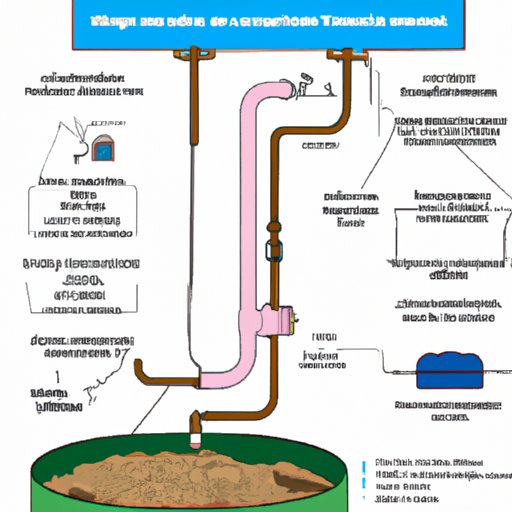Introduction
A septic tank is an essential part of any home or business that does not have access to a municipal sewage system. In many rural areas, septic tanks are the only way to properly treat and dispose of wastewater. But what exactly is a septic tank and how does it work? This article will provide a comprehensive guide to understanding a septic tank diagram, explaining the anatomy of a septic tank, how wastewater is treated, and how to diagnose and repair common issues.
Explaining the Process: A Step-By-Step Guide to Understanding a Septic Tank Diagram
The most important thing to understand about a septic tank is that it is a self-contained system for collecting and treating wastewater from toilets, sinks, showers, and other fixtures in a home or business. The wastewater flows into the tank and is treated by bacteria within the tank before being released into a leaching field or other disposal system. Here’s a step-by-step guide to understanding a septic tank diagram.
Anatomy of a Septic Tank
A typical septic tank diagram includes several key elements. The first is the inlet pipe, which carries wastewater from the home or business into the tank. The tank itself is usually made of concrete, fiberglass, or plastic and is designed to contain the wastewater while allowing solids to settle to the bottom. The outlet pipe carries the treated wastewater out of the tank and into the leaching field or other disposal system. The tank also has two baffles, one at the inlet and one at the outlet, which help to keep the solids in the tank and prevent them from entering the disposal system.
Inflow and Outflow of Water
When wastewater enters the septic tank through the inlet pipe, it is broken down by bacteria within the tank. As the wastewater is broken down, solids settle to the bottom of the tank and form a layer of sludge. The wastewater then flows out of the tank through the outlet pipe and into the leaching field or other disposal system. The baffles in the tank help to keep the solids in the tank and prevent them from entering the disposal system.
The Role of Bacteria in Breaking Down Waste
Bacteria play an essential role in breaking down waste in a septic tank. Without these beneficial bacteria, solids would accumulate in the tank and eventually cause it to become clogged. To make sure the bacteria remain active, it is important to maintain the correct balance of oxygen, nutrients, and water in the tank. Regular maintenance, such as regular inspections and cleanings, can help to ensure this balance is maintained.
Comparing Different Types of Septic Tanks: Understanding the Pros and Cons of Each Design
There are several different types of septic tanks, each with their own pros and cons. Gravity-fed systems are the most common type of septic tank, relying on the force of gravity to move wastewater through the tank and into the leaching field. Pressure systems use a pump to move the wastewater through the tank, but require more maintenance than gravity-fed systems. Aerobic systems use oxygen to break down the wastewater, but require more energy and may need to be connected to a power source.
Gravity-Fed Systems
Gravity-fed systems are the most common type of septic tank, relying on the force of gravity to move wastewater through the tank and into the leaching field. These systems are typically less expensive than other types of septic tanks and require less maintenance. However, they are more prone to clogging due to the slow movement of wastewater through the tank.
Pressure Systems
Pressure systems use a pump to move the wastewater through the tank, allowing for faster flow rates and more efficient treatment. These systems are more expensive than gravity-fed systems and require more maintenance, but they are less likely to become clogged and can handle higher volumes of wastewater.
Aerobic Systems
Aerobic systems use oxygen to break down the wastewater, resulting in a cleaner effluent than traditional septic tanks. These systems are more expensive and require more energy, since they must be connected to a power source. They are also more complex and require more maintenance than other types of septic tanks.
Pros and Cons for Each System
Each type of septic tank has its own advantages and disadvantages. Gravity-fed systems are typically less expensive and require less maintenance, but are more prone to clogs. Pressure systems are more expensive and require more maintenance, but are less likely to become clogged. Aerobic systems are more expensive and require more energy and maintenance, but produce a cleaner effluent.

Visualizing the Functionality: An Illustrated Guide to the Inner Workings of a Septic Tank
Understanding a septic tank diagram is one thing, but visualizing the inner workings of a septic tank can be another. To help you better understand the process, here is an illustrated guide to the components of a septic tank and how wastewater is treated.
Components of a Septic Tank
The most important components of a septic tank are the inlet and outlet pipes, the tank itself, and the baffles. The inlet pipe carries wastewater from the home or business into the tank, while the outlet pipe carries the treated wastewater out of the tank and into the leaching field or other disposal system. The tank is designed to contain the wastewater and allow solids to settle to the bottom. The baffles in the tank help to keep the solids in the tank and prevent them from entering the disposal system.
How a Septic Tank Works
When wastewater enters the septic tank through the inlet pipe, it is broken down by bacteria within the tank. As the wastewater is broken down, solids settle to the bottom of the tank and form a layer of sludge. The wastewater then flows out of the tank through the outlet pipe and into the leaching field or other disposal system. The baffles in the tank help to keep the solids in the tank and prevent them from entering the disposal system.
How Wastewater is Treated
The bacteria in the septic tank break down the solids in the wastewater and release gases into the atmosphere. The treated wastewater is then released into the leaching field or other disposal system. The leaching field is designed to allow the wastewater to slowly filter back into the ground, where it is naturally purified by soil and vegetation.

Making Sense of Maintenance: A Comprehensive Overview of Septic Tank Care and Repair
Maintaining a septic tank is essential for ensuring that it continues to operate properly. Regular inspections and cleanings can help to prevent clogs and other issues from occurring. It is also important to identify signs of damage or malfunction, such as odors or slow drainage, and to take steps to address the issue. If repairs are needed, it is important to hire a qualified professional to ensure that the job is done correctly.
Regular Inspections and Cleanings
Regular inspections and cleanings are essential for maintaining a septic tank. During an inspection, a qualified professional will check the tank for damage and make sure that it is operating properly. During a cleaning, the professional will remove any solids that have accumulated in the tank and ensure that it is functioning efficiently.
Identifying Signs of Damage or Malfunction
It is important to be aware of potential signs of damage or malfunction in a septic tank. These can include slow drainage, gurgling sounds, bad odors, or water pooling around the tank. If any of these signs are present, it is important to take steps to address the issue as soon as possible.
Recommended Repairs
If repairs are needed, it is important to hire a qualified professional to ensure that the job is done correctly. Common septic tank repairs include replacing the inlet or outlet pipes, repairing the baffles, or installing a new tank. In some cases, the entire system may need to be replaced.

Troubleshooting Common Issues: A Practical Guide to Diagnosing Septic Tank Problems
Septic tanks can experience a variety of issues over time, including clogs, leaks, overflows, and odors. Here are some practical tips for troubleshooting these common problems.
Clogs
Clogs can occur when too much solid material builds up in the tank. This can be caused by failing to regularly inspect and clean the tank, or by introducing too much grease or other materials into the system. If a clog occurs, it is important to hire a qualified professional to clear the clog and make sure the tank is functioning properly.
Leaks
Leaks can occur in the inlet and outlet pipes, or in the tank itself. If a leak occurs, it is important to identify the source of the leak and repair it as soon as possible. In some cases, the entire system may need to be replaced.
Overflow
Overflow can occur if the tank becomes too full. This can be caused by not regularly inspecting and cleaning the tank, or by introducing too much water into the system. If an overflow occurs, it is important to take steps to reduce the amount of water entering the tank and to clear any blockages or debris that may be causing the overflow.
Odor
Odors can occur if the bacteria in the tank become inactive. This can be caused by a lack of oxygen, too much water, or too much solid material in the tank. If an odor is present, it is important to inspect and clean the tank to restore the balance of oxygen, nutrients, and water in the system.
Conclusion
A septic tank is an essential part of any home or business that does not have access to a municipal sewage system. Understanding a septic tank diagram is the first step to properly maintaining and caring for your septic tank. This article provided a comprehensive guide to understanding a septic tank diagram, explaining the anatomy of a septic tank, how wastewater is treated, and how to diagnose and repair common issues. Be sure to schedule regular inspections and cleanings to ensure that your septic tank remains in good condition and continues to operate properly.
(Note: Is this article not meeting your expectations? Do you have knowledge or insights to share? Unlock new opportunities and expand your reach by joining our authors team. Click Registration to join us and share your expertise with our readers.)
